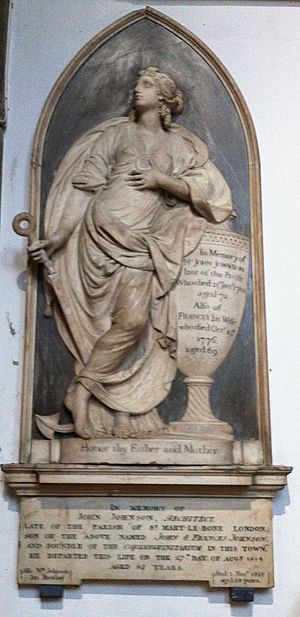John Johnson (architect, born 1732) facts for kids
Quick facts for kids
John Johnson
|
|
|---|---|

John Johnson (painted by John Russell)
|
|
| Born | 22 April 1732 Leicester, England, United Kingdom
|
| Died | 17 August 1814 (aged 82) Leicester, England, United Kingdom
|
| Nationality | English |
| Occupation | Arcitecht and Surveyor |

John Johnson (born April 22, 1732 – died August 17, 1814) was a famous English architect. He also worked as a surveyor for the county of Essex. A surveyor measures and maps land. Johnson is most famous for designing the Shire Hall, Chelmsford.
Contents
John Johnson's Life Story
John Johnson was born in Leicester, England. Before he turned 30, he moved to London. In the late 1760s, he started working with William Berners. They built many houses in an area of London called Marylebone.
Johnson lived in one of these houses on Berners Street for most of his life. In 1782, he became the official Surveyor for the County of Essex. He held this important job for 30 years. He retired when he was 80 years old.
In 1785, Johnson joined a bank called Dorsett and Co. The bank was located on Bond Street. However, the bank closed down in 1797. After this, Johnson moved from Berners Street to Camden Town. When he retired in 1812, he moved back to Leicester. He passed away there in 1814.
John Johnson was buried in St Martin's Church. This church is now known as Leicester Cathedral. There is a special memorial to him there. It is part of a monument originally built for his parents.
Buildings Designed by John Johnson
John Johnson designed many different types of buildings. Some of his most famous works are still standing today. He created public buildings and large country houses. He also worked on projects in London.
Important Public Buildings
- The Jockey Club's clubhouse in Newmarket (built 1771–1772). This was a meeting place for horse racing fans.
- The Shire Hall, Chelmsford (built 1789–1791). This building was used for county meetings and courts.
- The City Rooms, Leicester (built 1799–1800). This was a grand building for social events.
- Ingrams Close at Felsted School (built 1799–1802). This was a building for a school.
- Chelmsford Cathedral (rebuilt the nave, 1801–1803). He helped rebuild a main part of this large church.
- St Andrew's Church, Hornchurch (rebuilt the south aisle, 1802). He rebuilt a side section of this church.
- County Hall in Lewes (built 1808–1812). This building later became the Lewes Crown Court.
Grand Country Houses
- Castle Ashby (rebuilt the Great Hall, 1771–1774). He updated a large hall in this historic house.
- Terling Place, Essex (built 1772–around 1780). A beautiful country estate.
- Woolverstone Hall, Suffolk (built 1776). Another large country home.
- Bradwell Lodge, Essex (around 1785). He rebuilt parts of an older house.
- Benhall Lodge, Benhall, Suffolk (built 1790). Only a small part of this house remains today.
- Hatfield Place, Hatfield Peverel, Essex (built 1791–1795). A large country house.
London Projects
- Asia House, at 63 New Cavendish Street, Marylebone (around 1775–1777).
- Galloway House, at 29 Charles Street (built 1775–1776). This large house was built for a nobleman. It was later taken down in 1912.


